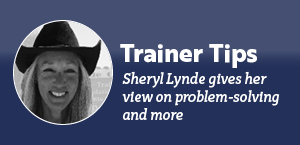By Sheryl Lynde | Horsetrader columnist

After careful consideration, a buyer selects a horse for purchase. Within 30 days of ownership, however, the buyer notices subtle changes in behavior. With time, the unwanted changes become more prevalent, and new vices surface.
The buyer calls the seller for advice, only to hear, “well, the horse never did that here.”
Frustrated, the buyer begins to feel that perhaps the horse was misrepresented. The horse they now ride is not the horse they rode while at the seller’s.
Who is right? They both are.
The seller offering the horse had prepared it well to sell. The horse was ridden four or five days per week in varying weather and in a variety of environments such as arena, trail and outside venues. The seller provided a well-balanced diet that met the caloric demands of his exercise regimen. Supplements were included with his morning feed. On the days the horse was not ridden, he was regularly turned out in a large paddock area.
The buyer rode the horse several times on the seller’s premises prior to purchase. The calm demeanor and manners of the horse far exceeded that of other horses they had considered. The buyer moved forward with the purchase, and after the horse successfully completed a pre-purchase vet check, the deal was sealed. The buyer had inquired at the time of purchase as to the horse’s diet which they replicated. Due to the buyer’s family responsibilities and a demanding work schedule, they were able to ride perhaps 1-2 times per week — some weeks more, some less. The horse lives in a box stall with an attached run. On weeks when there was no opportunity to ride, the buyer brought the family out to visit the horse and provide grain, supplements and carrots.
The first initial rides went great — again, the buyer loves the training of the horse. The horse is a little distracted by his new surroundings, but his calm and willing disposition remains intact. After the ride, he is bathed and returned to his stall along with a portion of grain, supplements and carrots.
After subsequent rides, the buyer notices the horse hesitating, wanting to stall and stop upon leaving the barn. He begins calling out to his stall mates. The once willing disposition fades and his refusals become more prominent. More behaviors begin to surface, such as jigging when headed home and refusing to load in the trailer. The new owner becomes frustrated and feels a loss of control building with each ride. The more fearful they get, the less time they make to ride.
There isnt any wrongdoing in either scenario, it’s just different lifestyles that produce different results.
With the seller, the horse had been exercised regularly multiple times per week with boundaries consistently and clearly defined. The seller was honest — they had not experienced the behaviors the buyer was experiencing. The seller was able to assess the horse’s intentions and provide consistent guidance prior to a behavior manifesting. Any testing of those boundaries was met with clear and decisive correction. The horse’s feeding program was based on the amount of exercise given. Regular turnouts were provided on the days the horse was not worked.
With the buyers, due to the demands on their time, the horse’s workouts had been greatly reduced, but their portions of grain and feed remained the same. The horse was fed its grain after each ride instead of in the morning. After the purchase, for a short time the horse’s previous training held; however, without clear and consistent boundaries provided, the horse found and exploited the holes in the new rider’s leadership role. The buyer was now riding their training — or lack thereof. The once consistent boundaries became blurred. If the horse stalled or hesitated, so did the buyer’s response because their wasn’t a full understanding of the intent behind the horse’s actions. Once the horse’s behavior was not corrected — just like a kid — they continually repeated it because they could.
The buyer was also correct. This was no longer the horse they had ridden at the sellers. Neither scenario is right or wrong. Different lifestyles can and do produce different results. When purchasing a horse, always take into consideration how the horse was used, how often it was ridden and their feeding program. Make adjustments in the program if you are not able to ride as often. Overfed and underworked is not a good combination. Feeding supplements or grain in the morning and not after your ride will greatly reduce the horse’s inclination to hurry back to the barn. Be prepared to make corrections consistently. Different rider, different horse.
The horse tells you what it’s going to do before before it does it. Look for solutions and never stop learning.
Leaders are learners.
–Sheryl
Leave a Comment
All fields must be filled in to leave a message.